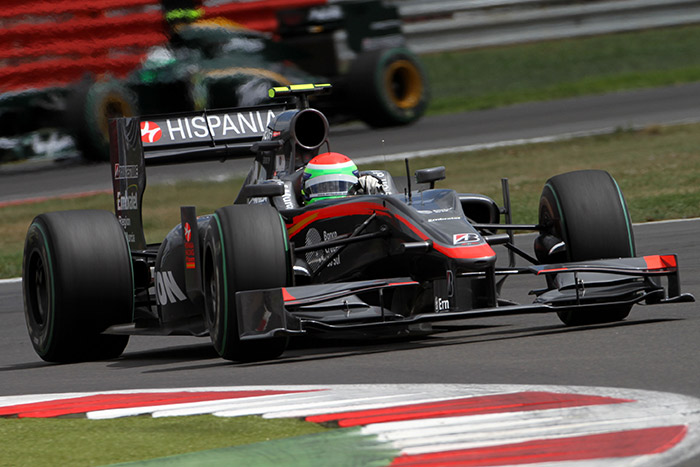HRT F110 Cosworth

Active: 2010
Team: HRT F1 Team
Team: Luca Pignacca (TD), Ban Agathangelou (CA), Gabriele Tredozi (CD), Geoff Willis (Technical advisor), Colin Kolles (TP)
Drivers Bruno Senna, Karun Chandhok, Christian Klien, Sakon Yamamoto
The F110 is the first car of the brand new Hispania Racing team, one of three new teams entering Formula One in 2010 - the other being Team Lotus and Virgin Racing. The team was initially destined to enter as Campos Racing, but when payments to chassis partner Dallara and engine supplier Cosworth could not be fulfilled, the business was sold and renamed.
The financial issues meant the team were on the back foot even before the season started. HRT unveiled their 2010 challenger on 4 March 2010 in Murcia, Spain, too late for pre-season testing. Under new team principal Colin Kolles, the car was rushed to Bahrain in order to compete in the first race of the season.
That rush to the first race meant the team had to go for steel brakes for the first few races, incurring a major performance penalty compared to other teams' carbon-carbon brake systems.
Design and development of the chassis happened by Italian racing car constructor Dallara, but was clouded by weeks of uncertainty during the financial problems of the team when it was still known as Campos. Still, once the car hit the track, technical consultant Geoff Willis was critical of the product delivered by Dallara, even though he admitted that conditions were difficult during development.
"Frankly I'm disappointed. I was expecting better," Willis said about the HRT car early April. "There a lot of reasons why this design has been compromised, not least because the programme was stopped and started, stopped and started. So there's quite a lot of corners that were cut in the last few weeks to get to Bahrain.
"But fundamentally I'm disappointed at the level of engineering in the car and I don't think it reflects current F1 practise by quite some margin. Now you put that down to time, some of it down to experience, some of it down to finance, but I think overall, even allowing for those things, I'm disappointed with what I see. I'm thinking just of the built quality, the design quality, the refinement of the design. I think it's missing a lot of tricks that would be taken for granted by anybody in the pitlane now."
The comments, along with financial issues and the team seeking an arrangement with Dallara to be able to get a hold of the designs to avoid reverse-engineering it for further development eventually led to a split with Dallara on 26 May.
Performance
The car hadn't run at all before the Bahrain Grand Prix, and even there, they were hardly ready to get going. Senna's car was ready for three installation laps in first practice, and 17 laps in the second session before sliding off with a wheel coming off. The second car wasn't seen until Saturday as mechanics failed to sort the clutch and gearbox on Chandhok's car on Friday.
Senna and Chandhok qualified on the last row of the grid, in 23rd and 24th position, both retiring early. This improved somewhat, but retirements were frequent, and qualifying results usually resulting in back row starts. All things together meant the car was the backmarker of 2010, scoring no points, but still finishing the season 11th in the Constructors' Standings thanks to a 14th place finish from Senna at Australia and Chandhok at Korea.
Specifications
Chassis: Carbon fibre and honeycomb composite Monocoque
Front Suspension: Carbon fibre Double wishbone with pushrod operating torsion springs and anti roll-bar via rocker
Rear Suspension: Carbon fibre Double wishbone with pushrod operating torsion springs and anti roll-bar via rocker
Dampers: Lineal hydraulic dampers
Fuel Tank: Kevlar reinforced rubber fuel cell
Steering Wheel: Carbon Fibre with integrated Dash electronics and instrumentation
Steering System: HRT Hydraulic servo assisted system
Gearbox: X-Trac seven-speed “Quick-Shift” sequential semi-automatic shift
Clutch: Carbon Multi Plate
Brake Material: Carbon brake discs and pads
Brake Callipers: 6 pistons all round
Cooling System: Aluminium oil, water and gearbox cooler
Seat Belts: OMP
CockPit: Removable seat made of anatomically formed carbon composite and six-point seat belt & HANS system
ECU and Logging System: FIA standard ECU & FIA homologated electronic & electrical system
Wheel Rims: Magnesium alloy
Tyres: Pirelli P Zero
Dimensions
Overall Width: 1800mm
Car Weight: 640Kg (Minimum FIA weight)
Engine
Designation: Cosworth CA2010
Duty Cycle Type: 4 stroke reciprocating piston, normally aspirated
Configuration: 8 cylinders in banked V configuration with an angle of 90 degrees
Construction: Cast aluminium alloy cylinder block and head, forged aluminium pistons, steel crankshaft
Capacity: 2,400cc
Valves: 32 with pneumatic valve springs
Maximum Speed: Limited to 18,000rpm
Timing: Double overhead cams driven via compliant gear from crankshaft
Mass: In excess of 95kg
Cylinder Bore: Less than 98mm
Fuelling: 8 injectors supplied by a pressurized system at 100bar
Ignition: 8 ignition coils each driving single spark plug
Lubrication: Dry sump
Spark Plugs: Champion
